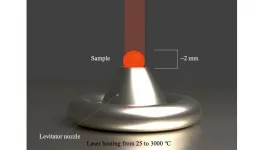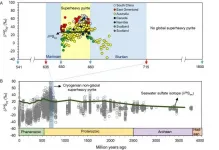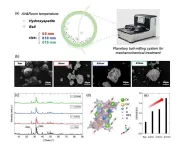(Press-News.org) Low doses of a four-drug combination helps prevent the spread of cancer in mice without triggering drug resistance or recurrence, shows a study published today in eLife.
The findings suggest a new approach to preventing cancer metastasis in patients by simultaneously targeting multiple pathways within a metastasis-promoting network. They may also help identify people who would most likely benefit from such treatment.
Metastasis, the spread of cancerous cells through the body, is a common cause of cancer-related deaths. Current approaches to treating metastatic cancer have focused on high doses of individual drugs or drug combinations to hinder pathways that promote the spread of cancer cells. But these approaches can be toxic to the patient, and may inadvertently activate other pathways that cause the drugs to stop working and the tumours to return.
"There is an urgent need for new strategies to suppress cancer metastasis, especially for cancers such as triple-negative breast cancer that currently lack effective therapies," says first author Ali Yesilkanal, a postdoctoral scholar at the Ben May Department for Cancer Research at the University of Chicago, US.
In the study, Yesilkanal and colleagues analysed gene expression data from patients participating in the Cancer Genome Atlas study to understand how a metastasis-suppressing protein called Raf Kinase Inhibitory Protein (RKIP) works. They found that RKIP reduces the expression of a network of genes that promote the spread of cancer cells.
They then created a four-drug combination that mimics how RKIP suppresses the ability of cancer cells to spread. They administered low doses of this treatment to mice with metastatic cancer that mimics metastatic breast cancer, and found that it blocked the spread of cancer and increased the animals' survival. Importantly, the treatment did not trigger the compensatory mechanisms that often cause high-dose, anti-metastasis drugs to stop working and tumours to return.
Finally, the team used computer modelling to explain why reducing, but not completely stopping, the expression of this network of genes helped prevent metastasis without triggering drug resistance or relapse. They also identified patients with breast cancer in the Cancer Genome Atlas who might be most likely to benefit from such treatment based on their cancer's gene expression patterns.
"Our findings could lead to a new cancer treatment strategy where patients first receive low-dose combination drugs that block metastasis and then receive traditional cancer treatments such as radiation, chemotherapy or immunotherapy," says co-senior author Marsha Rosner, the Charles B. Huggins Professor at the Ben May Department of Cancer Research at UChicago.
"Our results challenge current approaches to cancer treatment and suggest an alternative strategy for controlling metastasis in breast cancer and potentially other types of cancer," concludes co-senior author Alexandre Ramos, Group Leader at the School of Arts, Sciences and Humanities, University of São Paulo, Brazil.
INFORMATION:
Media contact
Emily Packer, Media Relations Manager
eLife
e.packer@elifesciences.org
+44 (0)1223 855373
About eLife
eLife is a non-profit organisation created by funders and led by researchers. Our mission is to accelerate discovery by operating a platform for research communication that encourages and recognises the most responsible behaviours. We aim to publish work of the highest standards and importance in all areas of biology and medicine, including Cancer Biology, while exploring creative new ways to improve how research is assessed and published. eLife receives financial support and strategic guidance from the Howard Hughes Medical Institute, the Knut and Alice Wallenberg Foundation, the Max Planck Society and Wellcome. Learn more at https://elifesciences.org/about.
To read the latest Cancer Biology research published in eLife, visit https://elifesciences.org/subjects/cancer-biology.
A new study from the University of Chicago has found that the photosynthetic bacterium Synechococcus elongatus uses a circadian clock to precisely time DNA replication, and that interrupting this circadian rhythm prevents replication from completing and leaves chromosomes unfinished overnight. The results, published online on May 10 in Proceedings of the National Academy of the Sciences, have implications for understanding how interrupted circadian rhythms can impact human health.
Circadian rhythms are the internal 24-hour clock possessed by most organisms on earth, regulating ...
Argonne scientists across several disciplines have combined forces to create a new process for testing and predicting the effects of high temperatures on refractory oxides.
Cast iron melts at around 1,200 degrees Celsius. Stainless steel melts at around 1,520 degrees Celsius. If you want to shape these materials into everyday objects, like the skillet in your kitchen or the surgical tools used by doctors, it stands to reason that you would need to create furnaces and molds out of something that can withstand even these extreme temperatures.
That's where refractory oxides come in. These ceramic materials can stand up to blistering heat and retain their shape, which makes them useful for all kinds of things, from kilns ...
May 11, 2021 - Like other medical specialties at the start of the COVID-19 pandemic, orthopaedic surgery rapidly pivoted from in-person visits to remote appointments via telemedicine. Analysis of that initial experience finds that some groups of patients faced persistent or worsening disparities as the shift to telemedicine occurred, reports Clinical Orthopaedics and Related Research® (CORR®), a publication of The Association of Bone and Joint Surgeons®. The journal is published in the Lippincott portfolio by Wolters Kluwer.
"We found concerning disparities in access ...
TAMPA, Fla. - A hallmark of cancer is its ability to evade the immune system. It is why researchers are focused on finding new strategies and targets to jumpstart the immune system so it can mount a response against tumors. One such target is the inhibitory receptor T-cell immunoglobulin and mucin domain 3 (TIM-3), a protein that is overexpressed in many different types of cancer and is associated with poor patient outcomes. It is known to block the activity of immune cells, such as dendritic cells, but how remains unclear. In a new article published in the journal Immunity, Moffitt Cancer Center researchers show that TIM-3 inhibits the STING signaling pathway in dendritic cells, thereby blocking their ability to elicit an immune response.
Dysregulation ...
Point:
Novel chiral diacid monomers were synthesized.
Chirally interactive BioNylons were prepared.
BioNylon showed thermal/mechanical performances than conventional Nylons.
BioNylons disintegrated and degraded with pepsin.
Summary:
Marine plastic waste problems have been more serious year by year. One of the worst issues is that creatures in ocean are going extinct by mistakenly swallowing them.. Conventional biodegradable plastics are degradable in digestive enzymes, but their performances are too low to use in society. In this study, researchers from JAIST have used bio-derived resources such as itaconic acid and amino acid for the syntheses of high-performance BioNylons having the pepsin degradation function.
Ishikawa, ...
Quantum mechanics can be used to create more stable and more easily produced organic solar cells. These are the findings of new research from the University of Gothenburg.
Organic solar cells have many advantages compared with traditional silicon-based solar cells. They can be manufactured cheaply at a large scale using printing presses, and they are light, malleable and flexible. The problem is that today's organic solar cells are not as stable and effective as silicon-based solar cells. In a new study, a research group has taken on this problem and found a way that can lead to more cost-effective solar cell technology.
"There are excellent opportunities for utilising quantum efficiencies to change different chemical ...
The Sturtian Snowball Earth glaciation (717~660 million years ago) represents the most severe icehouse climate in Earth's history. Geological evidence indicates that, during this glaciation, ice sheets extended to low latitudes, and model simulations suggest global frozen ocean as well as a prolonged shut-down of the hydrological cycles. The Snowball Earth hypothesis poses that the Sturtian global glaciation is directly triggered by intense continental weathering that scavenges atmospheric CO2, while the global frozen condition is terminated by ...
One of the most basic structural aspects of relativistic spacetime is the description of how time and distances are altered by motion. The theory of special relativity describes a spacetime framework for linear constant motion in which time dilates and lengths contract in response to motion. This framework is described by the Lorentz transformation, which encompasses mathematical formulas that describe how time and distance are altered between moving reference frames. The Lorentz transformation also describes how a stationary observer views time in the moving frame to be offset with distance. ...
One of the most prominent evils of rapid industrialization has been the emission of toxic pollutants into the surrounding biosphere, with often disastrous consequences for human beings. Several industrial processes, such as chemical manufacturing and printing, along with facilities such as power plants emit volatile organic compounds (VOCs) that are known to be cancer-causing and raise an important environmental issue in need of a solution. Traditionally, VOCs are controlled via a process called "catalytic oxidation," in which they are converted into benign materials in the presence of noble metal (e.g. gold, silver, and platinum) ...
A new study from the University of Surrey has revealed 'real world' factors that influence people's interest in adopting a dietary pattern called time-restricted feeding.
According to NHS England, 67 per cent of men and 60 per cent of women in the UK are overweight or obese - with more than 11,000 yearly hospital admissions directly attributable to obesity.
Time-restricted feeding, which is a type of intermittent fasting, is the practice of restricting the time between the first and last food intake each day - therefore prolonging the daily fasting period.
In a study published by the ...




